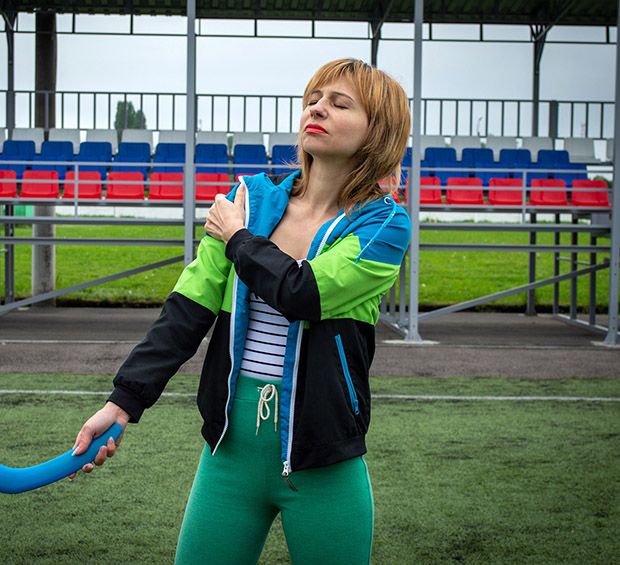Calcific tendonitis treatment option: Focused shock wave, the new option?
For many people, calcific tendonitis might be nothing short of debilitating, which means there’s a need for new and innovative treatments which may help patients navigate this difficult disorder. There are medical advances every single day that allow us to remain hopeful about the eventual eradication of any condition – and focused shock wave therapy offers tremendous hope to its patients. If you have calcific tendonitis, you might find relief from any kind of extracorporeal shock wave therapy, but focused could be the better choice. With this in mind, here’s a comprehensive guide on how we use focused shock wave therapy.

What is calcific tendonitis?
What is calcific tendonitis?
Calcific tendonitis is when calcium builds up in a person’s tendons; sometimes in one location, but also possibly in several parts of the body at once. This can lead to intense pain, especially if these deposits grow, or face any kind of irritation. Whilst it can affect the entire body, the deposits and their associated symptoms typically first manifest in a person’s shoulder, or their rotator cuff. This area may also face rotator cuff tendinitis, which does present similar symptoms but doesn’t involve calcium build-up – understanding the specific form of tendonitis you have is instrumental in getting the right treatment.
This condition is most prevalent in women, and usually around the age of 40-60; though people of any age and gender can still get it. Professionals and experts are still unsure what causes this disorder, but it could be due to normal wear and tear. This means it might spontaneously develop with no prior warning – making it absolutely essential that you have a complete understanding of this condition and the effective treatment options. There are three distinct stages of calcific tendonitis, including:
The pre-calcific stage
This is when normal motion is substantially more difficult than usual, and can even cause pain.
The calcific stage
At this stage, the cells release calcium in the form of deposits, which the body starts to resorb.
The post-calcific stage
This is when the range of motion slowly returns to normal and healthy tissue replaces the deposits.
An introduction to Extracorporeal Shock Wave Therapy (ESWT)
An introduction to Extracorporeal Shock Wave Therapy (ESWT)
Extracorporeal shock wave therapy is a special form of treatment that uses low-energy audible sound waves to improve the body’s natural healing process – such as by increasing blood flow. This is a non-invasive procedure that focuses mainly on the symptomatic area; meaning nothing pierces your skin. At the London Shock Wave & Sports Injury Clinic, we offer both types of this technique, and the science shows this is a very effective method for treating calcific tendonitis. This procedure usually involves the application of ultrasound gel on the affected area to help enhance the shock waves and their overall conductivity.
When using the radial form of extracorporeal shock wave therapy, there can be some minor discomfort, which simply doesn’t exist when using focused F-ESWT. No matter which form you choose, these sessions only take a short amount of time, around 5 minutes or so. The number of follow-up sessions you’ll need typically depends upon the rate at which the body shows signs of improvement, though this is often about four sessions. We aim to leave at least a week between each ESWT treatment, and this is so we can maximise the effects of each individual session.

The differences between radial ESWT and focused ESWT
The differences between radial ESWT and focused ESWT
The two main forms of extracorporeal shock wave therapy are radial and focused, both of which can serve as a helpful and effective calcific tendonitis procedure – especially for shoulder treatment. Radial ESWT is the more common (and more affordable) of the two, with virtually any ESWT clinic offering this type of treatment, but it does come with several notable limitations. For example, the treatment depth is 3-4cm, and this just might not be enough to conduct comprehensive work on a patient. Though this allows its shock waves to spread out, the end result is less effective for specific areas.
As the name suggests, focused extracorporeal shock wave therapy (F-ESWT) is much more effective at treating specific parts of the body, allowing the process to directly tackle any calcium deposits. This is because it can go deeper into the body, with the shock waves having a depth of up to 12cm with the right attachments, allowing the high-density energy to better reach an affected area. As calcification doesn’t occur too close to the surface of the skin, it helps to use focused treatment – this is typically more expensive than a radial approach, but with a greater level of effectiveness.
The actual content of the shock waves is also different between the treatments, which is a key reason for their distinct effects. Radial ESWT applies a combination of ultrasonic pulses, slow shear waves, and acoustic pulses, which coalesce around the applicator’s tip; this is why it has such a short range. Focused ESWT uses a ‘cone’ of crystals that focus energy through an electrical current – creating a consistent wave of pressure that moves through the skin with ease. This also has less impact on the skin, making it much more comfortable than radial treatment, and allowing for higher doses.
How to book an F-ESWT appointment with us
How to book an F-ESWT appointment with us
At our clinic in Wimbledon, London, we offer focused extracorporeal shock wave therapy treatments and hope to make this innovative technique more available to everyone who needs it. Many ESWT clinics in the area and across the entire country only provide radial shock wave therapy, which still has its uses, but is far less effective than focused shock wave therapy for calcific tendonitis. The London Shock Wave & Sports Injury Clinic is happy to continuously embrace innovative medical techniques such as focused ESWT, and we aim to make the entire process easy to understand.
We believe it’s essential that you know exactly what treatment you’re getting, including how it works, and the answers to any questions you might have about it. The more you know what to expect going in, the easier this procedure can be; helping to assuage any nervousness or anxiety might also make ESWT more effective. If you have any questions about calcific tendonitis and how F-ESWT could help you with it, you’re always welcome to <a href="https://shock-wave-therapy-london.co.uk/contact-us/">ask us your questions today</a>. Our expert team can make sure that you fully understand your options before any treatment begins.
If you’re currently dealing with calcific tendonitis and need a new therapeutic method that promotes natural healing, then focused extracorporeal shock wave therapy may be exactly what you need. Feel free to take your time and look into the procedure to see if it’s the right fit for you, but it can be best if you ask us directly about how it works. Alternatively, if you’re already certain that you want to try F-ESWT due to its healing effects, you can contact us, or give us a call at 020 8540 3389.

What evidence currently exists to support ESWT?
What evidence currently exists to support ESWT?
This is a common question, which is understandable, as patients want to be absolutely sure that the treatments they select are likely to succeed. With extracorporeal shock wave therapy being a relatively new method, some people are at first skeptical about its effectiveness, but there is a wealth of scientific literature that supports its ability to treat calcific tendonitis. For example, a meta-analysis by the peer-reviewed medical journal Sports Health reveals that F-ESWT is an ‘effective treatment for calcifying tendonitis of the shoulder’ [1].
While not every patient achieves the same results, this is usually the case with any medical treatment. BioMed Research International, another peer-reviewed journal that specialises in biomedicine, also put together a large-scale ESWT trial to chart its impact on patients [2]. They looked at 42 patients over the course of their trial – and conclude the treatment is ‘effective’, also saying that ESWT is ‘strongly recommended’ for ‘improving the pain, functionality, and quality of life’ of participants.
Another endorsement comes from Physician and Sportsmedicine, a peer-reviewed sports medicine journal that looked at 45 people with calcific tendonitis in their shoulders [3]. Their research determined that ESWT is indeed effective when it comes to improving motion and functionality in a patient’s shoulder – there was also a significant reduction in the calcium deposit’s size. The assessment ultimately concluded that both radial and focused treatments could offer tremendous results for patients, and quickly reverse the symptoms they’re experiencing.
The verdict on F-ESWT
There are plenty of studies and trials which come to the same conclusions about focused extracorporeal shock wave therapy; that it’s an effective treatment worth investing in if you have calcific tendonitis. For best results, it helps to look into focused treatments rather than radial ones, which offer less relief – and usually cause pain in the process. When dealing with calcific tendonitis, it’s important you find the approach which works for you, and the F-ESWT services at London Shock Wave & Sports Injury Clinic can help you with this. <a href="https://shock-wave-therapy-london.co.uk/contact-us/">Get in touch with our team</a>, and we’ll work to address your calcific tendonitis using innovative shock wave treatment.
References
- Focused Extracorporeal Shock Wave Therapy in Calcifying Tendinitis of the Shoulder, Sports Health. March 2009; 1(2): 137–144 – https://www.ncbi.nlm.nih.gov/pmc/articles/PMC3445068/.
- Effects of High-Energy Extracorporeal Shockwave Therapy on Pain, Functional Disability, Quality of Life, and Ultrasonographic Changes in Patients with Calcified Rotator Cuff Tendinopathy, BioMed Research International. March 2022; doi:10.1155/2022/1230857 – https://pubmed.ncbi.nlm.nih.gov/35281612/.
- Focused, radial and combined shock wave therapy in treatment of calcific shoulder tendinopathy, The Physician and Sportsmedicine. December 2020; 49:4, 480-487 – https://www.tandfonline.com/doi/abs/10.1080/00913847.2020.1856633.
Request a call back to learn more
If you're coping with painful Epicondylitis think shock wave therapy could help, we'd love to help. Request a call back now to find out if this effective treatment could be suitable for you.